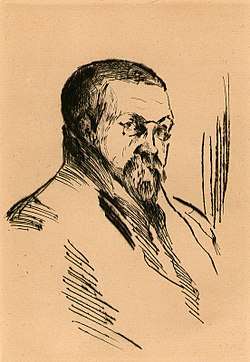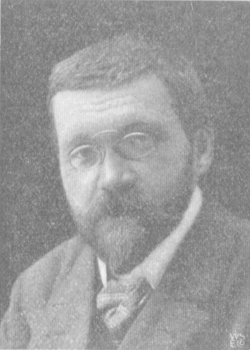Tryggve Andersen
Tryggve Andersen (27 September 1866 – 10 April 1920) was a Norwegian novelist, poet and story writer. [1]


Biography
Andersen was born in Ringsaker in Hedmark, Norway. He was one of ten children born to Christen Andersen (1825–93) and Antonette Krogvig (1840–1932). His father was a trader and later bailiff. When Andersen was nine years old, the family moved to Tysnes in Hardanger. In 1878, Andersen entered Bergen Cathedral School. He later attended school in Hamar and took his student exams in 1885. He attended the University of Kristiania until 1892, but did not graduate. He subsequently became an office worker in Hamar. [2][3]
Andersen made his literary debut in 1897 with the historical novel collection I Cancelliraadens dage, a collection of tales from the early 1800s in the Norwegian Uplands. It was received with great enthusiasm and earned him an endowment. The book is commonly viewed as a highlight in Andersen's work. It is regarded a pioneer work of its kind, and has later been analyzed by several literary historians. [4]
Among his other works are the poetry collection Digte from 1898, and the novel Mod kvæld from 1900. Between the years 1904-19, he published five collections of narratives and novels including Gamle folk og andre fortællinger (1904), Bispesønnen og andre fortellinger (1907), Hjemfærd (1913) and Fabler og hændelser (1915). [5]
Andersen suffered from various health problems. From adolescence, Andersen suffered from melancholy and depression. In later years he was diagnosed with epilepsy. He died in Gran during 1920. He has been portrayed by painters Henrik Lund, Olav Engebrigtsen and Karl Konow. Sculptor Jens Munthe Svendsen (1869-1957) made a bronze bust of him in 1920.[5][6] [7]
Personal life
He was married three times; in 1898 with Margrethe Schønberg (1871-1901); in 1906 with the author Regine Normann (1867-1939); in 1914 with Margarethe Tichauer (1891-1938).[8]
References
- Carl Nærup (1905). "Tryggve Andersen". Illustreret norsk Litteraturhistorie. Siste Tidsrum 1890-1904. Retrieved April 1, 2018.
- "Tryggve Andersen". Bokselskap. Retrieved April 1, 2018.
- "Tryggve Andersen - en kort biografi". Høgskolen i Hedmark. 25 November 2001. Archived from the original on 27 September 2005. Retrieved April 1, 2018.CS1 maint: BOT: original-url status unknown (link)
- Beyer, Edvard. "Tryggve Andersen". In Godal, Anne Marit (ed.). Store norske leksikon (in Norwegian). Oslo: Norsk nettleksikon. Retrieved 4 August 2012.
- Dahl, Willy. "Tryggve Andersen". In Helle, Knut (ed.). Norsk biografisk leksikon (in Norwegian). Oslo: Kunnskapsforlaget. Retrieved 4 August 2012.
- Anne Aaserud. "Karl Konow". Norsk kunstnerleksikon. Retrieved April 1, 2018.
- Oscar Thue, Sigrid Rømcke Thue. "Jens Munthe Blichfeldt Svendsen". Norsk kunstnerleksikon. Retrieved April 1, 2018.CS1 maint: uses authors parameter (link)
- Erik Bjerck Hagen. "Regine Normann". Store norske leksikon. Retrieved April 1, 2018.